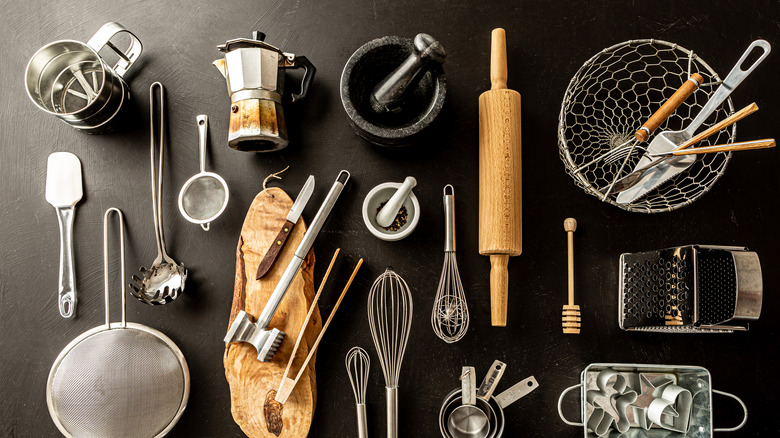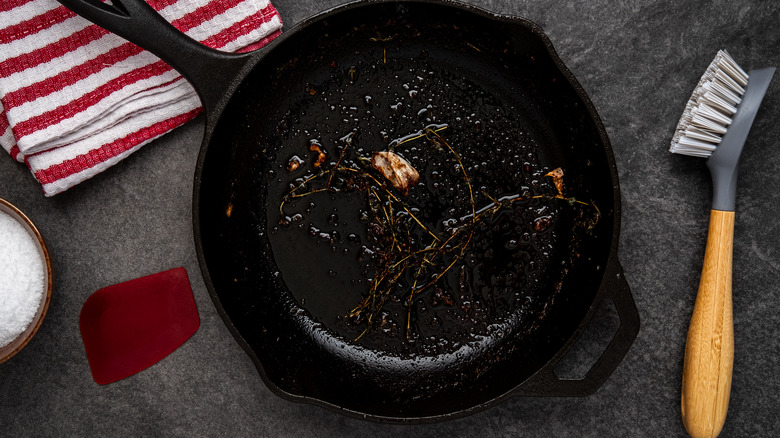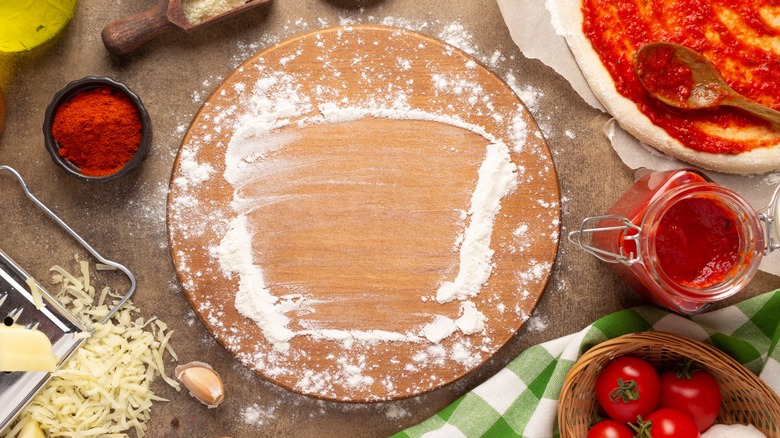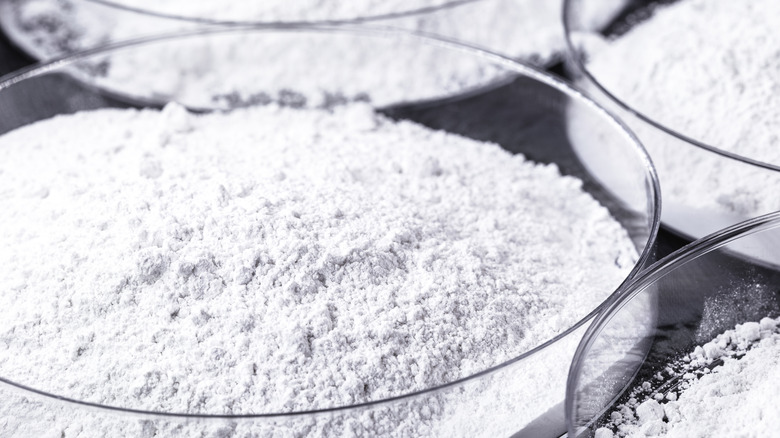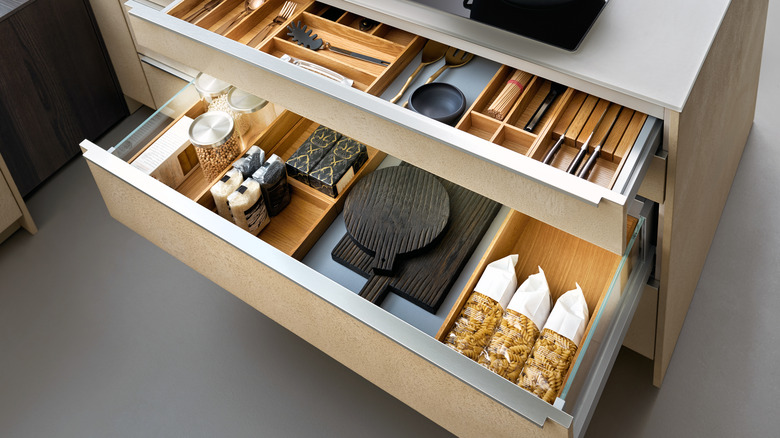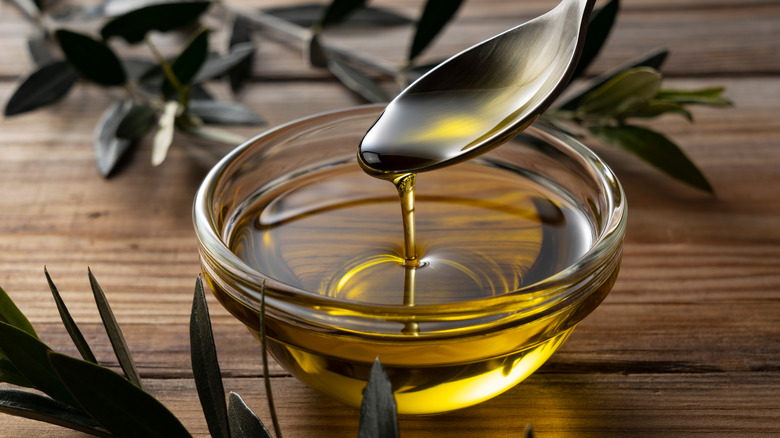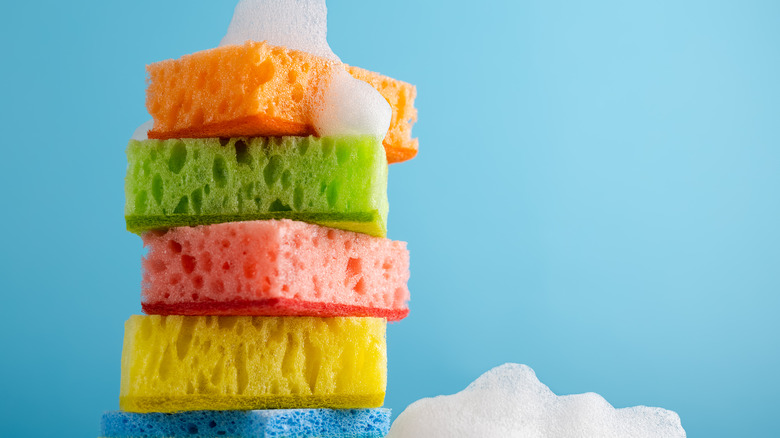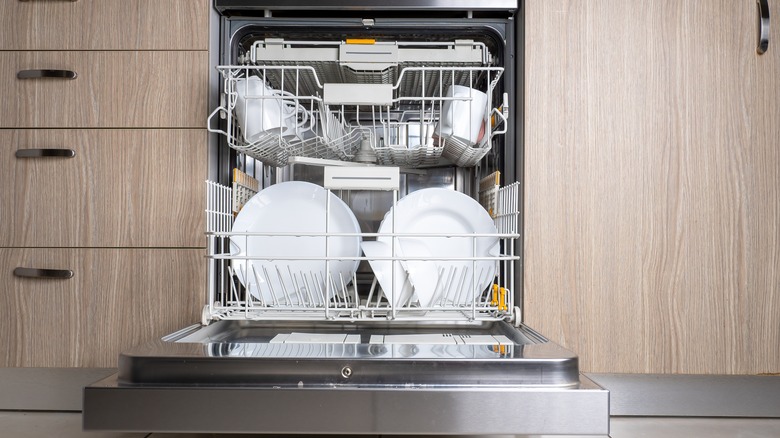The Proper Way To Clean A Pizza Stone
Pizza stones have become a kitchen must-have in recent years, especially for households that love creating their own artisan pizza. After all, not much is better than family pizza night where everyone plays a hand in choosing their toppings! As Sonshine Kitchen explains, there are some compelling reasons to invest in a pizza stone as a kitchen staple. First, cooking with a pizza stone creates a perfect crust on every pie. That's because they facilitate even baking. Additionally, the porous nature of the stone absorbs unwanted moisture from the dough, allowing the crust to crisp up very nicely. Another reason to get your own pizza stone is affordability. Coming in at a reasonable rate, they can help you make more pizza at home rather than ordering in, which will save you money in the long run. Doesn't it sound appealing to make your own artisan pizzas that taste just as good – if not better – than takeout?!
However, something that plagues pizza stone users is how they can effectively clean the tool. It's a bit more complex than cleaning a baking sheet. While it's definitely a bit more nuanced to get your pizza stone clean as a whistle, once you get the process down, it's incredibly easy to do. Keep reading to learn how you can clean your pizza stone for perfect pies every time you set out for a pizza night!
Make sure you have the right cleaning supplies
To clean your pizza stone properly, you'll need the right supplies to complete the process. The good news here is that you don't need much to successfully make your pizza stone as good as new. However, you need some materials you may not already have lying around the house. In addition, some of the materials you need may come as a surprise!
First, you'll need a sturdy metal spatula. This will be used to help you scrape any baked-on food or debris off of the stone, which can be pesky and a bit trying to release. Next, you'll need either a stone brush, scouring pad, or sandpaper. Yes, you read that right: sandpaper!
The Pizza Heaven explains that a pizza stone brush typically has steel or brass bristles along with a long handle. This makes it easier to reach every inch of the stone. The abrasive bristles are best for getting rid of those stubborn stains that tend to accumulate after a pizza stone is used, thanks to pizza ingredients like sauce and oil. These brushes are also designed to handle heat, which allows you to get the debris and stains off the stone while the tool is still hot from use. The website further explains that pizza stones tend to attain a buildup of burnt-on debris due to the flour used on the stone to prevent the dough from sticking to it during the baking process. This is simply unavoidable, which makes the cleaning and scraping process important, and it's hard to do without a brush like this. However, if you're in a pinch, sandpaper is a good replacement material to assist in the effort.
Make sure you have a few dishcloths on hand for your cleaning efforts – they'll definitely be useful before the process is finished! Finally, you will want to have an oven mitt or pot holder on hand if you're going to be cleaning the pizza stone while it's still hot from use. Safety first!
Scrape away debris
The next step in cleaning your pizza stone is to scrape away debris, which is where that stone brush comes in so handy! This is probably the most time-consuming part of the cleaning process, but it's key to getting your pizza stone truly clean. Your metal spatula will also be helpful in this effort. Home Stratosphere shares a look at different types of spatulas that all kitchens should stock, and metal spatulas are noted to have a few distinct pros associated with them. First, they're durable and long-lasting. Second is why they're useful in cleaning your pizza stone: they're known to handle heavy food and tough jobs thanks to their durability. Finally, metal spatulas are able to stand up to heat, which is useful here if you're going to be cleaning your pizza stone while it's still hot from use.
In this step in the process, it may be possible to scrape away all the debris without using any water. However, if you have any stubborn pieces that won't budge, add a small amount of warm water to the stone and continue scraping and scrubbing until the more stubborn pieces come loose. This is an important step in the process, so keep at it until you're able to get rid of as many pieces of baked-on gunk as possible for the best results.
Wipe the stone clean
Here is where your dishcloth comes into play! After you've gotten rid of the baked-on debris, you need to dampen a cloth and wipe the pizza stone clean. That means wiping away any of that debris that you've scraped off that may be sitting on the surface of the stone from your efforts.
If you're wondering what kind of cloth to use for this part of the process, CNN provides a great breakdown of the best dishcloths on the market. The article notes that they favor Swedish dishcloths. These could be a great choice for this cleaning project because they're somewhat of a cross between a dishcloth and a paper towel. They're more absorbent than traditional dishtowels, yet they're more durable than a piece of paper towel. Plus, since they're reusable, they're a much more sustainable option, too!
These dishcloths are a combination of cellulose and cotton, and they're an affordable option worth looking into. Just the slightest bit of water dampens these dishcloths and makes them the perfect candidate for wiping your pizza stone completely clean and making sure you get all of that debris off of it before you move to the next step in the sanitizing process.
Make a paste to get rid of pesky stains
It's not uncommon for pizza stones to develop stains after repeated use. Especially because the porous material of the stone absorbs moisture from the dough and there's a chance for oil to seep into the stone, this happens more often than not. However, that doesn't mean that these stains can't be lifted and your pizza stone can't be made like new again! Doing so will take a little bit of extra TLC, but it'll be worth it nonetheless.
To get rid of these tough stains, create a baking soda paste. After you have scraped debris off of the stone and wiped it clean as outlined above, combine one part baking soda with an equal part water. Scrub the paste with your stone brush onto the stains, working to lift the oil. After you're done scrubbing, rinse the paste off with a small amount of water and then wipe the stone clean completely. Let the stone dry and admire your work!
As Expert Home Tips denotes, baking soda is not only an ingredient that helps cakes and breads rise as you bake them. It's also a useful – and affordable – cleaning agent in your home. Baking soda is mildly abrasive and a natural deodorizer that works to dissolve dirt and stains and can also cut through grime, making it a great addition to your cleaning arsenal for virtually any room of your home. Baking soda is commonly used in the kitchen to cut through grease and grime, making it a great way to combat oil stains like those on your pizza stone.
Most importantly - let the stone dry
After you're done scraping and wiping your pizza stone and getting rid of any stains that exist (if that step is needed), it's time for some patience. It's of paramount importance that you let your pizza stone dry completely before you use it again. In fact, using it while there's still moisture in the stone can cause your pizza stone to crack, which is something that many pizza stone owners experience but it mystifies them as to why it occurs. For that reason, it's important to let your pizza stone dry at least overnight – if not longer – to ensure you can use it safely after its cleaning.
Baking Steel shares a myriad of reasons why pizza stones tend to crack besides using it before it's completely dry. Temperature issues are the most common cause of cracked pizza stones. First, adding a cold baking stone into a hot oven can prompt a crack. This causes what's called "thermal shock," which leads to a fracture in the ceramic of the stone. Also, be careful about adding pizza dough that's too cold to your hot stone after it's been preheated. That's a surefire way to crack your stone, so you'll want to avoid putting frozen dough or anything right out of the fridge onto it. Finally, taking your stone out of a hot oven too soon could prompt a crack. This is because it can cause a shock to the stone due to the sudden temperature change. Be mindful of this as you handle your stone and bake your perfect pizza pie.
Store your pizza stone correctly
After your pizza stone is clean and you're ready to stow it until its next use, you'll want to store it correctly to keep it in wonderful condition. Since these stones are made of ceramic or stone, they're breakable by nature and need to be stored with care to avoid cracks or unwanted breaks. Pizza Informer offers several ideas for simple storage that will make sense in your space. Their first suggestion is to use a cabinet divider to store it with ease in a safe space, tucking it out of sight until you use it. Cabinet dividers – if not already installed – can be easily added to your cabinet or you can hire a local handyman to do it. Pizza stones are naturally heavy, so make sure to store yours on the bottom of a cabinet if possible or if you worry that the shelf cannot accommodate the weight of the object. Alternatively, if you have a skinny cabinet where you can slide the stone in vertically, that's another great option.
The site explains that others choose to store their pizza stone in the oven, even when it's not in use. Since pizza stones tend to be heavy, this could be an easier alternative than moving it between the oven and storage area before and after each use. You may also put it in the drawer beneath your oven for safekeeping. Since it's an oven-safe baking item, you don't have to worry about it getting too hot in the drawer.
Ensure your stone is primed for use
For best results with your pizza stone, you'll want to ensure that it's primed for use every time you go to make a delicious meal with it. Sprinkle Some Fun shares tips on how to prepare your pizza stone for successful baking. This is much like seasoning a cast iron pan or skillet, and there are a couple methods you can use to do so for your pizza stone. Think of this as breaking it in before it starts getting regular use. For the first method, you'll need cooking oil. Olive oil, vegetable oil, canola oil, coconut oil, or even Crisco will all work for this purpose. Start by putting a thin layer of oil on the stone, using a clean dishcloth to spread it around evenly. Then, heat your oven to 425 Fahrenheit and bake the pizza stone for about an hour. You'll find that when you pull it out, the shade of the stone will be darkened a bit. This will continue to happen the more you use your pizza stone!
Don't use soap on your pizza stone
It may seem like common sense to just clean your pizza stone with soap and warm water like you do other dishes. However, you may be surprised to learn that doing so could really damage your pizza stone. Home Cook World shares insight as to why using soap on your pizza stone is a no-no. The article explains that pizza stones are naturally made to be porous, so they absorb soap just as they absorb oils and other liquids. The problem is that soap has a very distinctive, non-delicious, smell and taste. That means that your pizza will taste and smell like soap – which is obviously not what you're going for when you're whipping up your own pie!
The site goes on to explain what to do if you do get soap on your pizza stone, though. The first option is to throw the stone in the oven. Bake it by itself at 400 degrees Fahrenheit for two hours, baking out the soapy residue. Another revival method comes from Giordano's pizza. These pie experts suggest covering the entire surface of the stone with unrolled crescent roll dough. Bake the dough as directed on the stone. As they bake, they'll soak up the soapy residue and flavor. After they're done, simply throw them in the trash and you'll have a pizza stone that's hopefully good as new!
Don't put your pizza stone in the dishwasher
Finally, another thing you can't do is throw your pizza stone in the dishwasher to get clean. That would be all too easy, right?! Kitchen Seer explains why using this time-saving and convenient appliance does not mix with your pizza stone. The reasoning for this is two-fold. First, pizza stones are – once again – very absorbent. If they are washed in the dishwasher, they'll absorb a whole lot of water. This will lead to the expansion of the stone and eventual cracking. Once a stone cracks, you will likely need to toss it and get a new one, because using a cracked stone in the oven can actually be dangerous.
The other reason you can't clean your pizza stone in the dishwasher is also attributed to the porous nature of the stone. It can easily absorb chemicals from the soap you use in your dishwasher. Not only would this be pretty bad for you to ingest from a health standpoint, but it would surely ruin the taste of your pizza. With that being said, these are pretty compelling reasons to go about cleaning your pizza stone the proper way. Doing so will help extend its lifespan and will also make your pizza taste that much better!


